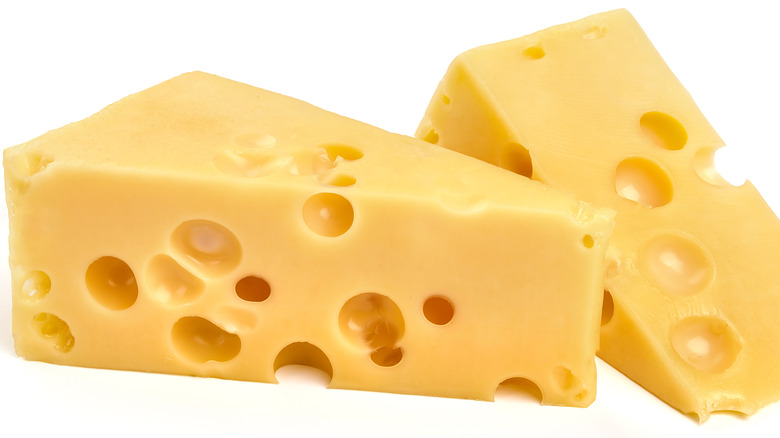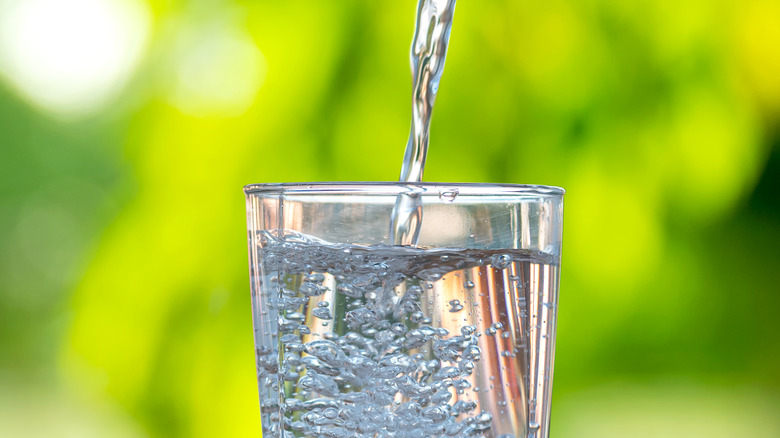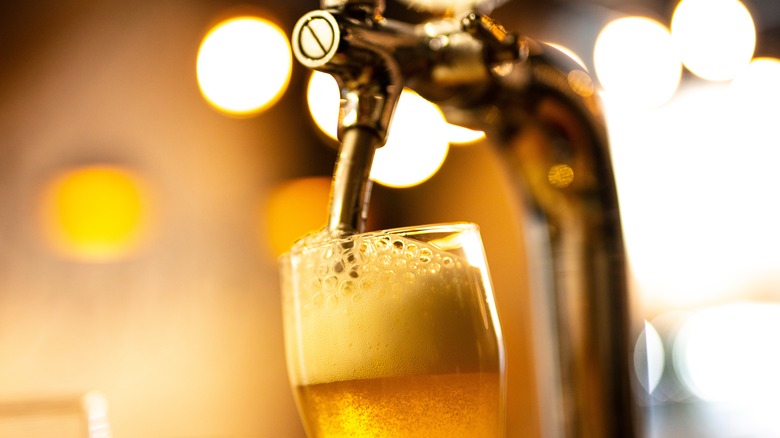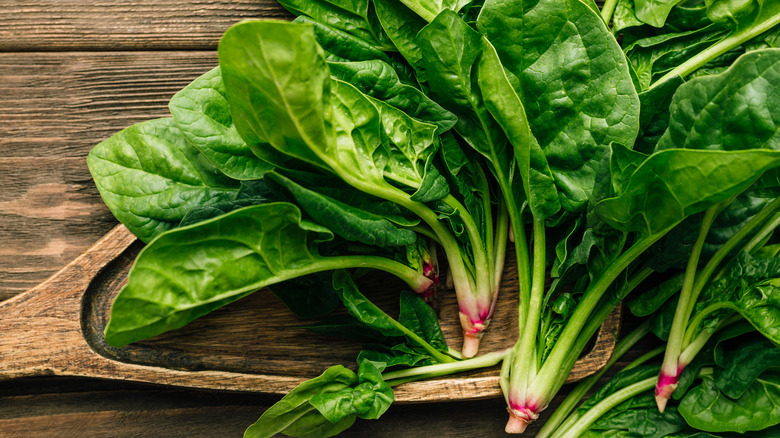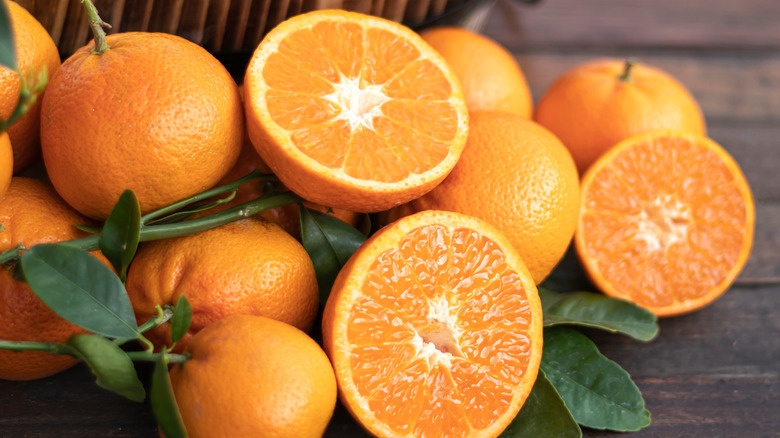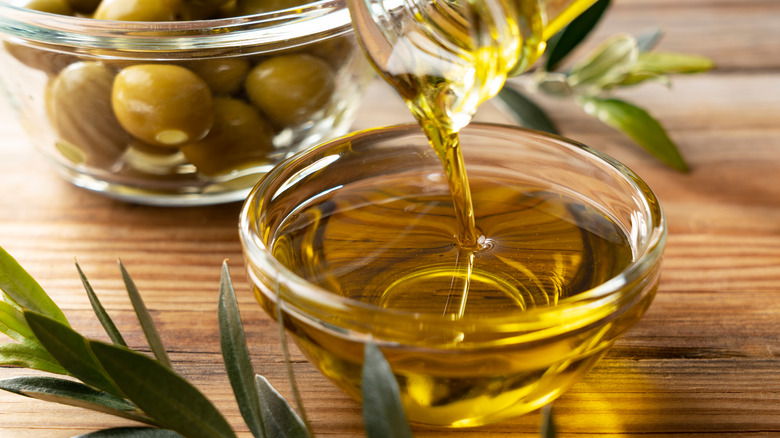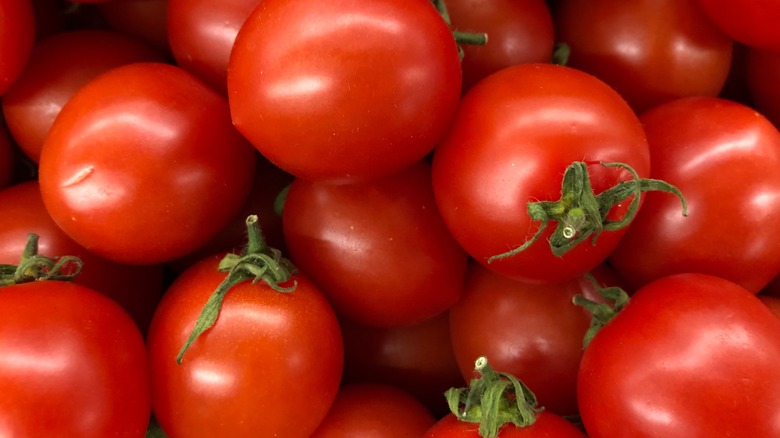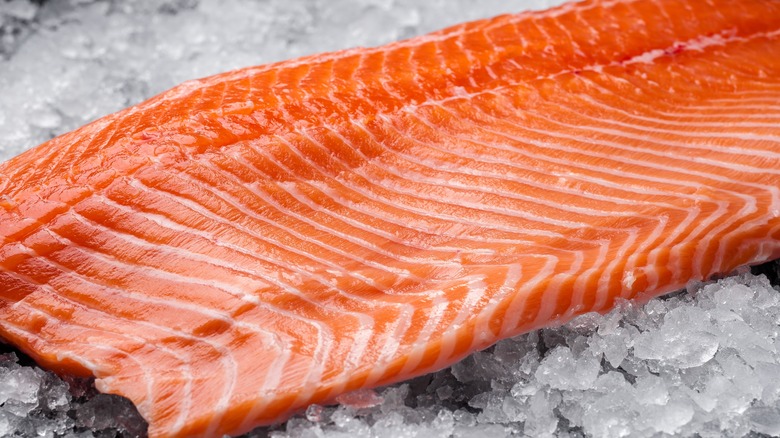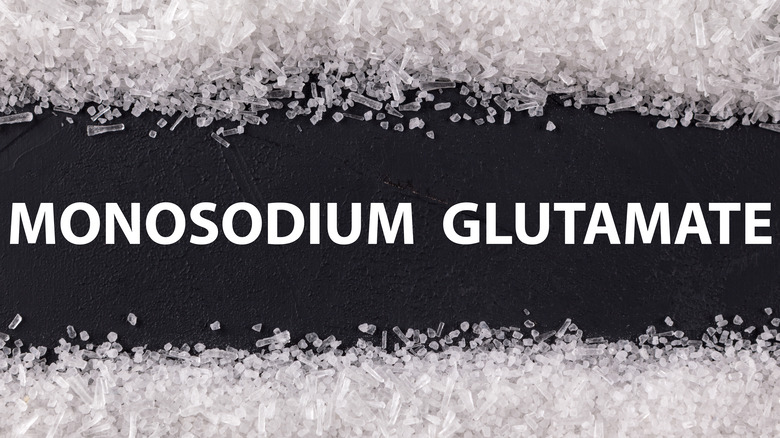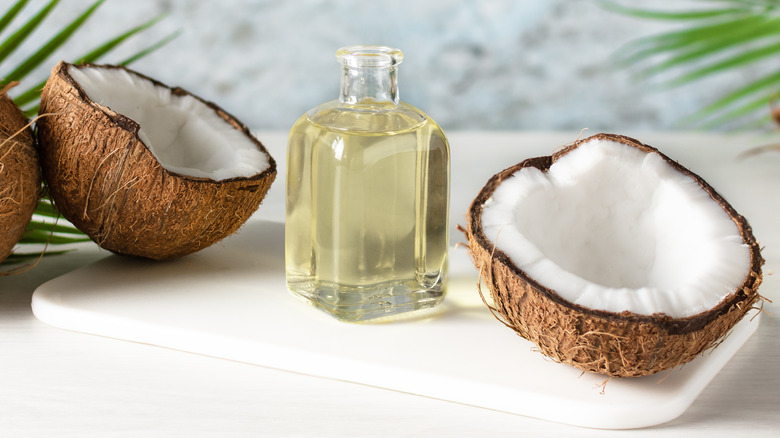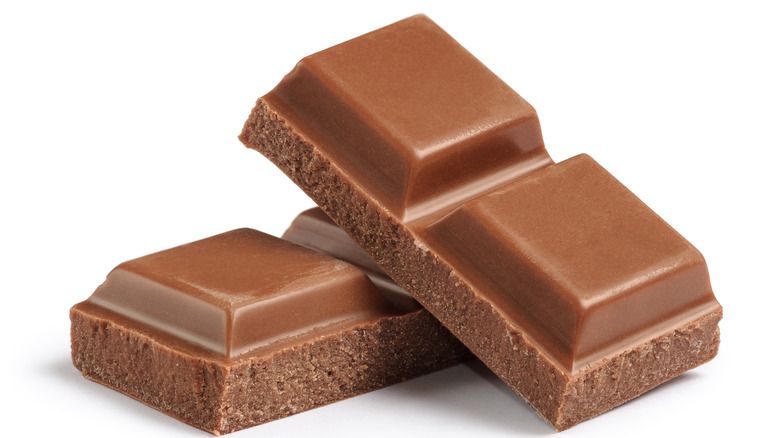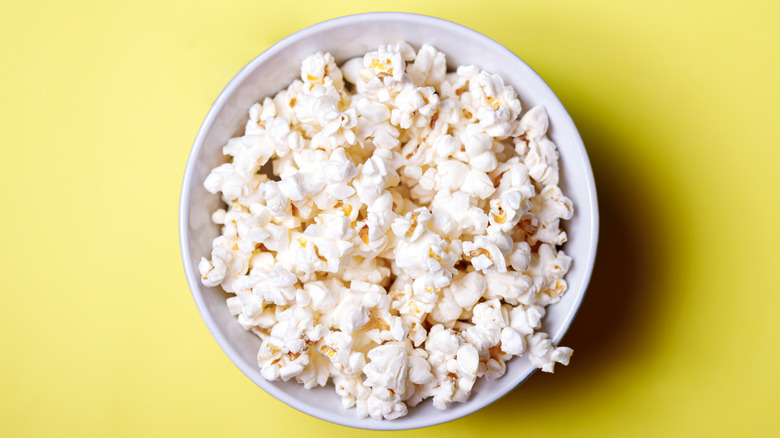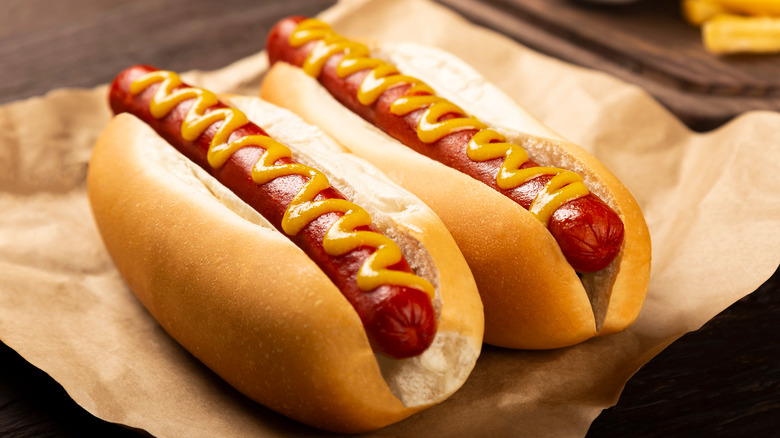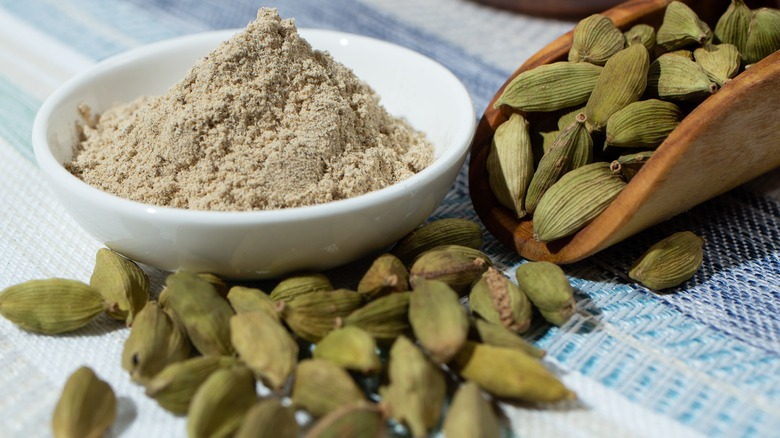7 Foods To Eat And 7 To Avoid When Following A Vestibular Migraine Diet
True or false: All migraines involve headaches. If you answered "true," you're not alone, since this is arguably one of the most well-known symptoms associated with migraines. However, a vestibular migraine doesn't always come with a headache, per Johns Hopkins Medicine. In fact, what this migraine is known for includes symptoms like vertigo, problems with balance, nausea, and vomiting, as well as sensitivity to motion, light, and scents. Fortunately, sometimes dietary changes can help eliminate certain vestibular migraine triggers.
According to Healthline, there isn't an official "vestibular migraine diet" menu. With that said, a common method for treating vestibular migraines is to first eliminate certain foods (typically for two to three weeks), and then slowly bring them back into one's diet one at a time over the next two to three weeks. This allows a migraineur to track patterns of when they eat certain foods and when they have attacks.
While trigger foods for vestibular migraines can vary from person to person, that doesn't mean there aren't foods that are at least suspected of setting off these migraines in some individuals. Not only that, but these potential trigger foods are sometimes possible culprits behind migraines and headaches in general. So, we'll be exploring some of the reasons why some foods might be triggering vestibular migraines, as well as other foods that could be helpful additions to a vestibular-friendly diet. However, even with this information, you should only try this elimination diet under the supervision of a medical professional.
Avoid: Aged cheeses
When you hear the phrase "aged cheeses," do you think of a wine tasting or an elegant dinner party? Or does your mind go to your health and how you might pay for eating those cheeses later? If you are prone to vestibular migraines, you probably thought of the latter scenario.
As Johns Hopkins Medicine points out, ripened or aged cheeses can be triggers for vestibular migraine attacks. And as WebMD explains, aged cheeses contain a substance called tyramine, which might trigger migraines. While the scientific community is still exploring the connection between tyramine and migraines, there are certain chain reactions that can occur because of tyramine that might lead to headaches. For example, your body needs to use a specific enzyme to break down tyramine. So, if you have lower levels of that enzyme and eat foods rich with tyramine, that might be a recipe for a headache. Also, tyramine might cause the brain to release different amounts of a chemical called norepinephrine, which could be a factor in how tyramine triggers headaches.
While not every cheese is loaded with tyramine, you might want to avoid these ones if you're on a vestibular migraine diet: blue cheese (including Stilton), Camembert, cheddar, feta cheese, Muenster, Parmesan, and Swiss cheese. However, you might want to ask a medical professional if cheeses that are lower in tyramine like American cheese, cottage cheese, and farmer's cheese are alright in certain amounts.
Try: Water
Chances are, you've often heard about how important it is to stay properly hydrated. But if you're prone to vestibular migraines, you have one more reason to make sure you're getting enough water. According to the Children's Hospital of Philadelphia, dehydration can trigger one of these migraine attacks. And no, you don't have to be severely dehydrated to experience a migraine (per American Migraine Foundation).
There are levels of dehydration (via eMedicineHealth), but even if you're only mildly or moderately dehydrated, that can be enough to trigger a headache and/or dizziness. And once you're moderately dehydrated, your condition has the potential to escalate into severe dehydration very quickly. Once this occurs, you might become lightheaded to the point that it that affects your ability to stand and walk. You also could experience a faster heart rate or a seizure, and even go into shock.
The bottom line: Not staying hydrated is not only the possible culprit behind a vestibular migraine, but also potentially life-threatening. The American Migraine Foundation recommends that migraineurs track how much fluid they're taking in and keep a bottle of water with them to potentially head off an attack. Of course, electrolytes can also be a factor when it comes to hydration (via eMedicineHealth).
Avoid: Alcoholic beverages
If you enjoy such drinks as bourbon or red wine but also get vestibular migraines, these and other alcoholic beverages might be off the menu. According to the Colorado Springs Ear Associates, these alcoholic drinks, as well as other ones like scotch, sherry, and port, are all typical triggers of migraines. Additionally, the American Physical Therapy Association notes that beer can also set off migraine attacks.
Of course, most people have at least heard of one type of headache that often occurs because of drinking—the infamous one that can happen during a hangover. And, yes, if you're prone to migraines, you're more likely to experience one of these delayed alcohol-induced headaches (DAIH), per the American Migraine Foundation. However, it's also possible for an alcoholic beverage to set off a migraine attack as quickly as 30 minutes after drinking it. And if you're thinking that this only happens with large amounts of alcohol, think again. Even a small amount could trigger a migraine attack in susceptible individuals.
Although it's believed that alcohol is a migraine trigger, there has been some debate if it's the alcohol itself or something else in alcoholic beverages that's the real culprit. For example, another potential migraine trigger, tyramine, is in such drinks. However, research so far points to the alcohol being the main contributing factor especially when combined with other potential triggers like stress and anxiety.
Try: Spinach
From jokes about children hating it to cartoons where it gives a certain sailor super strength, spinach is one of those foods that's very much in the public eye. But to be fair, not everyone wants to gobble it down like Popeye. However, even if spinach isn't your favorite food, you might want to give it a second try if you have vestibular migraines.
As Healthline explains, there are a number of foods that aren't allowed during the elimination phase of a vestibular migraine diet. Spinach, however, is not only allowed, but might even be beneficial for this health condition. According to the Newport-Mesa Audiology Balance and Ear Institute, there have been studies supporting that the riboflavin in spinach might help some migraineurs have attacks less often. With that said, the National Institute of Health Office of Dietary Supplements states that the research regarding riboflavin (a.k.a. vitamin B2) and migraines is mixed. Nevertheless, the Quality Standards Subcommittee of the American Academy of Neurology and the American Headache Society support riboflavin as a "probably effective" way to help prevent migraine headaches.
Although spinach might be a helpful for a migraineur, you should be careful about adding it to your diet if you're on blood thinners (via Healthline). This is because it contains large amounts of vitamin K1, which plays a role in blood clotting.
Avoid: Citrus fruits
Even if you're on a vestibular migraine diet, that doesn't mean you can't eat any fruits even if you're in the elimination phase. With that said, citrus fruits, especially in large amounts, can trigger vestibular migraine attacks (via ENT Health).
As Britannica notes, citrus fruits in general are pulpy and have "fairly thick skins." Common ones that you've probably seen often at the supermarket include grapefruits, tangerines, lemons, and limes. Both sweet and sour oranges are categorized as citrus fruits, as are citrons. Fun fact: The original member of this plant species that helped cultivate many of the ones sold commercially today is the shaddock or pummelo (per Britannica). But as Kaplan Clinic explains, there are members of the citrus family that contain a chemical compound called octopamine. And just as people who are sensitive to gluten might have health issues after eating whole wheat bread, it's theorized that someone sensitive to octopamine could experience a migraine. However, as research in the journal Neurology points out, "... there is no direct evidence supporting" that octopamine triggers migraines.
Even though the scientific community is still researching the possible connection between octopamine and migraines, it's still commonly recommended for vestibular migraineurs to avoid citrus fruit, per ENT Health. With that said, citrus fruits contain antioxidants, including ones that might help lower one's chances of developing specific cancers, via WebMD. So, if possible, it can be beneficial to eventually add them back into one's diet.
Try: Olive oil
With so many foods potentially off the menu for vestibular migraine patients, a vestibular migraine diet's elimination phase can feel very limited. And it's easy to fall into the trap of thinking that whatever's left will be bland. But the truth is that there are quite a few foods that are still all right to eat on this diet, as well as ways to add additional flavor to a migraine-friendly meal.
According to the Upper Cervical Health Centers Boise, olive oil (particularly, cold-pressed olive oil) can be a good food for vestibular migraineurs. Remember, olives are a type of stone fruit, and when a manufacturer presses them without using heat or additional chemicals, they create an oil that retains more of its nutritional properties, per WebMD. What's more, researchers from the Monell Chemical Senses Center in Philadelphia found that a compound in olive oil called oleocanthal could relieve pain as well as the nonsteroidal anti-inflammatory drug ibuprofen (via the Los Angeles Times). However, there is a catch. Oleocanthal is sensitive to heat, so cooking the oil destroys its potential pain-killing component. Also, aging olive oil has the same effect on oleocanthal.
Beyond containing oleocanthal, olive oil is also a good source of antioxidants and healthy fats (via WebMD). Because of this, olive oil (and especially cold-pressed olive oil) might help reduce inflammation. Additionally, cold-pressed olive oil is a good source of vitamins A, E, and K.
Avoid: Nightshades
There are a number of plant-based foods allowed during the elimination phase of a vestibular migraine diet. As the Upper Cervical Health Centers Boise notes, quite a few fruits and vegetables are all right to eat even if you're prone to these types of migraines. However, nightshades are definitely on the avoid list.
According to WebMD, fruits like peppers, tomatoes, and eggplants are types of nightshades. And yes, you read that correctly. Although we sometimes think of these foods as vegetables in part because of the ways they're prepared and served, technically all three are fruits. Potatoes, on the other hand, are vegetables and yet also nightshade plants. The reason all of them can still be classified together is because nightshades have a chemical called solanine, which helps protect these plants from insects. However, consuming large amounts of solanine can result in a number of health issues, including headaches. This is why eating green potatoes (which have higher amounts of solanine) can make someone sick. In fact, WebMD recommends an elimination diet that focuses on nightshades if you suspect they're the culprits behind not just headaches, but also problems like nausea or diarrhea.
Although nightshades can be a trigger for vestibular migraines, they do have their potential health benefits. For example, eggplants contain the antioxidant anthocyanin, which might lower the chances of developing diabetes and cancer, per WebMD. In addition, bell peppers are rich in vitamin C.
Try: Fish
As Newport-Mesa Audiology Balance and Ear Institute notes, fish are "vestibular-friendly foods." In fact, the Institute recommends adding more fish like cod, mackerel, salmon, herring, tuna, and halibut to your meals if you're on a vestibular diet. So yes, they can be good choices for a vestibular migraineur — but why?
Well, according to The Vertigo Doctor, a big factor could be the omega-3 fatty acids found in fish. To really understand this, we need to talk about two different nerves. When something affects the trigeminal nerve, it can lead to pain. However, the vertigo associated with vestibular migraines is because of the vestibular nerve. What can happen is a domino effect where the trigeminal nerve is impacted first, and then the vestibular nerve. Fortunately, the way omega-3s affect the nerve endings of the trigeminal nerve could reduce pain. This means adding fish to one's diet might reduce how often they have migraines, and make the migraine attacks they do get less severe.
Besides the above fish, other seafoods that are good sources of omega-3 fatty acids include shrimp and oysters. In addition, another vestibular migraine-friendly food on this list, spinach, contains omega-3s. So, a salmon dinner on a bed of spinach could be an ideal meal for someone on a vestibular migraine diet.
Avoid: MSG
Have you ever visited a restaurant and saw in their window or on their menu that they advertise that they don't use MSG? Maybe it's stated outright, or maybe it's simple the letters MSG inside a circle with a line through it. However it's displayed, there's a good reason why some places might want to make sure their customers know this controversial ingredient isn't in their food.
As the Mayo Clinic explains, MSG or monosodium glutamate is a flavor enhancer. And here's where things get a bit tricky: While the scientific community hasn't found conclusive evidence that MSG causes health issues like headaches, they also can't deny that many people over the years have reported experiencing problems after eating something containing MSG. In fact, the American Academy of Audiology states that MSG might be a trigger for vestibular migraines. What's more, the University of Wisconsin School of Medicine and Public Health has "a good general rule" for their headache elimination diet: avoid foods that contain MSG. These can include processed and canned foods, gravies, salty snacks, soups made from bouillons, ready-to-eat meals, veggie burgers, croutons, and breadcrumbs.
It's worth noting that the U.S. Food and Drug Administration (FDA) has classified MSG as generally safe (via Mayo Clinic). However, manufacturers do need to list it on the Nutrition Facts Labels of their products. But the University of Wisconsin still cautions to be careful about foods that say "natural flavoring."
Try: Coconut
When you think of a coconut, what's the first thing that comes to mind? Maybe your brain went to a tropical setting. Or perhaps you thought of a drink like a piña colada. But chances are the very first thought you had wasn't migraine-related.
And yet, according to Healthline, more than one coconut product can be a good choice to keep on your meal plan if you're doing a vestibular migraine diet. For example, while your doctor might recommend cutting out dairy products during the elimination stage of this diet, dairy substitutes like coconut milk are acceptable. Although olive oil is usually allowed during a vestibular migraine diet, not everyone likes its flavor. If you fall into that "not an olive oil fan" category, coconut oil can be a good alternative. In addition, Upper Cervical Awareness states that coconut water can be a good choice for women who are pregnant and getting migraines. This is because coconut water has electrolytes, which are good for staying hydrated. Remember, dehydration can be a vestibular migraine trigger (via Children's Hospital of Philadelphia).
Does this mean that coconut water is better for hydration than water? Well, Upper Cervical Awareness states that "... water is the optimal beverage to increase hydration ..." Also, it's important to pick a coconut water that has little to no added sugar. And of course, if you are pregnant, you should always speak with a medical professional before adding anything to your diet.
Avoid: Chocolate
There's debate surrounding this next food. But as Woman's World points out, many studies support that chocolate can be a trigger for vestibular migraines. So it's not surprising that a medical professional might recommend cutting it out during the elimination phase of a vestibular migraine diet.
But why might chocolate be a bad choice for a migraineur? Chocolate can contain caffeine and tyramine, both of which can trigger migraines (via Missouri State University). Furthermore, a study by researchers from the University of California, San Diego (via Science Alert) concluded that the nitrates in chocolate could be the culprits. The bacteria in our bodies help us digest food and beverages. When these bacteria break down nitrates, they create the waste product nitrite, which becomes nitric oxide. It's believed that nitric oxide's effect on blood vessels (causing them to dilate) could be the reason why some migraineurs experience attacks after consuming chocolate. Additionally, this study also connected the nitrates in other foods on this list — wine and processed meats — as potential migraine triggers.
Although there have been findings supporting chocolate as a potentially migraine-triggering food, Dr. Paul Durham, a professor of biology at Missouri State University, found the opposite results during his research. "Our data is the first evidence to support that cocoa-rich diets increase proteins that prevent neurons from firing and releasing inflammatory molecules that are thought to trigger migraines," he said. However, many chocolates have low cacao content, which, according to Dr. Durham, would make them less effective.
Try: Grains
Just as there are foods that might trigger a vestibular migraine, there are also ones that could be beneficial for someone with this health issue. Case in point, the Upper Cervical Health Center Boise categories grains like popcorn, buckwheat, oatmeal, and brown rice as "Vestibular Migraine Fighting Foods."
There's more than one type of grain on the market — in this case, that doesn't refer to, for instance, oats versus rice. As the Mayo Clinic explains, whole grains are just that — the entire seed — meaning these grains are packed with more nutrients like magnesium, folate, iron, and potassium than refined grains. So, in general, whole grains are usually the more nutritious choice for a diet. But what makes grains potentially good for a vestibular migraine diet? Well, for one, they are low in tyramine (via WebMD). While we're still researching and learning about migraines, there is evidence supporting that tyramine could be a trigger for them. Also, according to the Old Ways Whole Grain Council, studies have concluded that consuming whole grains might result in less inflammation.
Besides being allowed on a vestibular migraine diet, there's evidence that whole grains might also help lower the chances of developing heart disease, type 2 diabetes, and colorectal cancer (via Old Ways Whole Grain Council). They also might be beneficial for weight management and could reduce the odds of having a stroke.
Avoid: Processed meats
As Woman's World explains, some research has concluded that different types of processed meats can be bad choices for someone prone to vestibular migraines. Now, just to make sure we're all the same page, registered dietitian Colleen Doyle told NBC News that processed meats are just that — processed through such means as fermenting, smoking, salting, or curing. And they include foods like salami, deli meats, hot dogs, sausages, bacon, prosciutto, and canned meats.
So, what makes these meats potentially problematic for migraineurs? According to West Tennessee Healthcare, the culprit could be preservatives in processed meats. Specifically, nitrites like sodium nitrite and potassium nitrite can make one's blood vessels dilate and might trigger a headache. A study cited by Science Alert noted that when the bacteria in our bodies break down nitrates, they create nitrites. And as Doyle told NBC News, even if a company uses "natural sources of preservatives" like celery salt or powder, they are still adding nitrates to the meat. "They can still label their product 'nitrate-free', because those are natural and not synthetic, but they are nitrates nonetheless." And whether these natural nitrates have the same effect on the body as synthetic nitrates isn't currently known.
Additionally, West Tennessee Healthcare points out that processed meats also contain histamine and tyramine, both of which might be migraine triggers. Regardless of why processed meats could be setting off migraines, they are definitely foods to consider eliminating during a vestibular migraine diet.
Try: Certain herbs and spices
Maybe you don't care for foods that have a bit of a kick to them. And that's understandable. Dishes seasoned with herbs and spices aren't for everyone. But if you get vestibular migraines, then you might want to reconsider.
As the National Headache Institute explains, not only are certain herbs and spices allowed on a vestibular migraine diet, but they even label such foods as "Vestibular Migraine Fighting Foods." What's more, Migraine.com lists a number of herbs, spices, and seasonings as foods to keep on the menu if you're on a migraine elimination diet. The Institute specifically emphasizes the following as good choices for migraineurs: basil, bay leaf, black pepper, caraway, cardamom, celery seeds, chives, coriander, cumin, dill, ginger, mint, oregano, parsley, poppy seeds, rosemary, sage, savory, thyme, and turmeric. Additionally, according to an abstract in the Journal of AOAC International, there is "ample evidence" that herbs and spices can have health benefits. For instance, registered dietitian Gillian Culbertson told the Cleveland Clinic that there's evidence supporting black pepper's potential to reduce inflammation.
Although some herbs and spices might help with migraines, Migraine.com does caution that certain ones should be avoided on a migraine elimination diet. Anise, cinnamon, cloves, curry powder, hot paprika, and nutmeg all contain histamine, which might be a migraine trigger. Also, prepared foods that are made "with spices" could also have histamine, as well as MSG.


